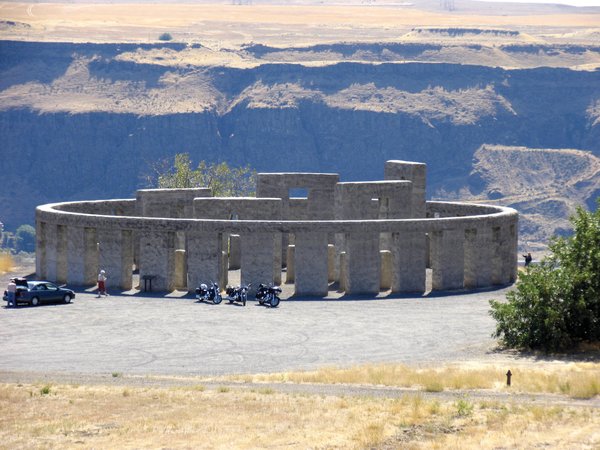 |
| Ricostruzione di Stonehenge a Maryhill, Washington, USA. |
Well, you can only take the word of folks. Will it be the British Archeology Society or Science Fiction?
English Heritage news release
The Stonehenge that people see today is not a 'fake' created in the 20th century, as a number of recent media reports have implied. Nor has English Heritage been seeking to conceal the fact that restoration work was carried out to the monument over the last century. The restoration work is fully documented in Stonehenge and its Landscape: Twentieth Century Excavations, published by English Heritage in 1995. It is also covered in books published by others, including Stonehenge Complete by Christopher Chippindale. Contemporary drawings, photographs and film footage survive and provide a fascinating visual record of the work in progress. Restoration of Stonehenge was prompted by the need to secure the stability of the monument, both for its own safety and for that of the people who were visiting it in increasing numbers. Nineteenth-century paintings, including those by JMW Turner and John Constable, show a number of the stones leaning at precarious angles and this is confirmed by photographs taken from the mid 1850s onwards. On the night of 31st December 1900, a storm felled one of the great sarsen uprights. Work to straighten and reset the stones began the following year and continued in phases until 1964. The work was carried out by prominent archaeologists of the day, under the supervision of the Society of Antiquaries (jointly, from the 1920s, with the Ministry of Works), and was fully recorded. In the late 1950s, a number of stones which had fallen were re-erected, but the great majority of the restoration work involved the straightening and resetting of stones which had become unstable. Meticulous care was taken to return the stones to their exact original positions, and no new stones were brought in. Today's Stonehenge, although considerably ruined, is the monument that was erected by prehistoric man some 3,500 years ago, not an imaginative reconstruction. Had the restoration work not been carried out, it is likely that by now Stonehenge would consist of a pile of fallen and broken stones - an ignominious end for one of the world's greatest prehistoric monuments. The fact that the 20th century history of Stonehenge is not covered in detail in the visitor guidebook is due, quite simply, to shortage of space - packing the story of such a complex monument into 36 pages requires judgements to be made about what information is most important to people's understanding of it. In recent years there has been increasing interest in the management of historic sites and the questions of whether, and how, they should be restored. The Stonehenge guidebook is due for updating this year and we will be trying to include more information about how recent generations have interacted with the monument. The 20th Century restoration work 1901 Professor William Gowland - supervised by Society of Antiquaries Stone 56, the upright of the central trilithon, which was leaning at an angle of about 60 degrees, was straightened and reset in concrete following full excavation and recording of the stone pit. 1919 - 26 Colonel William Hawley - supervised by Society of Antiquaries / Ministry of Works Hawley was assistant to Gowland, who was by this time too infirm to take on the task himself. Hawley undertook several seasons of varying length throughout this period. The work started as the result of a condition survey undertaken by the Ministry of Works following the donation of the monument to the nation by Sir Cecil Chubb in 1918. The first phase tackled stones 6 and 7 and their lintel in the outer circle, which were leaning at precarious angles. The lintel was removed and the two uprights were supported in metal and wood frames whilst the stone pits were excavated, then winched upright and cemented into place. The lintel was replaced on 17 March 1920 and the event was filmed by Gaumont. The next phase tackled stones 29, 30, 1 and 2 and their three linking lintels. The same methodology as above was used to straighten the stones and reset them in place, ending with the replacement of the lintels in December 1920. From 1919 to 1926, Hawley excavated a large proportion of the eastern part of the monument, in a programme of work that is considered over-vigorous by today's standards. 1950 - 1964 Professor Richard Atkinson, Professor Stuart Piggott and Dr JFS Stone Supervised by the Ministry of Public Buildings and Works / Society of Antiquaries This period saw the stabilisation of some of the stones and the re-erection of others which had fallen. In 1958, trilithon 57/58 was re-erected with its lintel and stone 22 (the one that fell on 31st December 1900) was re-erected. In 1959, stone 60 was re-erected. The necessary documentary evidence existed to enable these fallen stones to be returned to their exact original positions. In 1964, trilithon 53/54 was straightened and reset. Over this period, excavations were carried out around a number of the sarsen stones and bluestones. | |
| Sources: http://www.britarch.ac.uk/stonehenge/stone23. |



